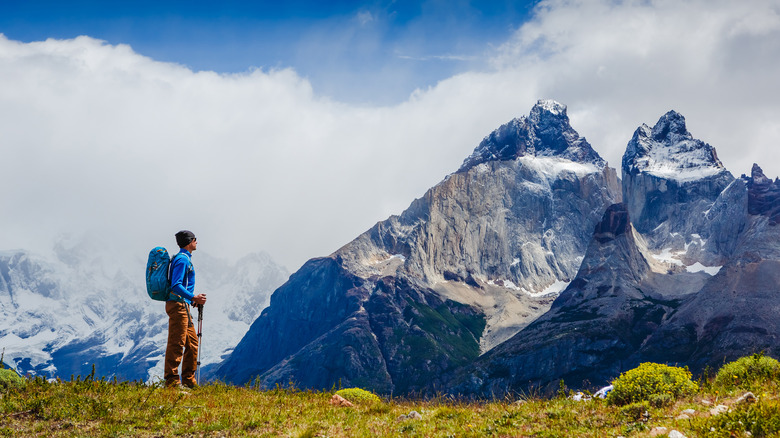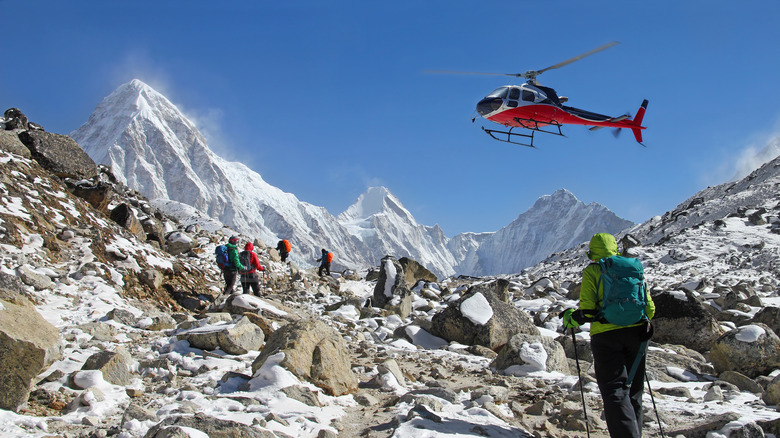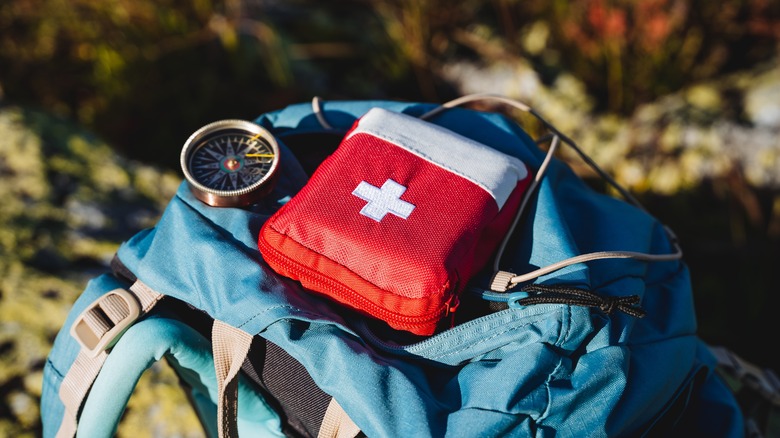The Scary Reason Hiking In This Popular South American Region Is So Dangerous
Patagonia, a region covering 260,000 square miles shared by Argentina and Chile, is a dream destination for all sorts of outdoor enthusiasts seeking to immerse themselves in the beauty of nature. Majestic mountains, pristine glaciers, and vast wilderness are the hallmarks of the hiking mecca (not the eponymous outdoor clothing brand). But, beneath its stunning vistas lies a daunting reality: for the unprepared or unaware, outdoor activities in Patagonia can, quite literally, mean life or death. It contains one of the most dangerous parks in the world.
Patagonia is infamous for its extreme weather conditions, which can change from serene to severe in minutes. The region is situated at a high latitude where the clash of oceanic and continental weather systems creates a volatile climate. Within Patagonia are six distinct regions, each with its own environmental features. Hikers can experience all four seasons in a single day, from sudden snowstorms to fierce winds reaching up to 100 miles per hour. Avalanches, rockfalls, surprise crevasses, and other hazards regularly pop up.
The allure of Patagonia's wilderness is also what makes it so dangerous. Much of the region is remote and difficult to access. Trails are not always well-marked, and in some remote areas, they may not be marked at all. In such isolated areas, rescue operations are significantly more complicated. A simple ankle sprain can become life-threatening if help cannot arrive in time. Moreover, spotty cellular coverage in vast stretches of Patagonia means that hikers cannot easily call for assistance.
Rescue operations in Patagonia
The hardest truth to swallow is the fact that there is no formal rescue team that services Patagonia. For the most part, all rescues are done by a group called the Comisión de Auxilio El Chaltén, a volunteer team of experienced mountain guides who risk their own lives to help climbers in danger. However, sometimes an emergency rescue cannot be done. The most reliable lifeline, if it can be considered that, is other climbers who may be around to help or self-rescue.
What about helicopters? Not really an option. There is a shortage, and of the few available, most are not prepared for long-line rescues. Of 120 rescue operations over the past 20 years, only 17% involved a helicopter in some capacity (via Explorersweb). In 2014, an attempted helicopter rescue ended in a tragic crash, taking the pilot's life. Due to high winds and long, remote distances, helicopters cannot safely enter the region. Instead, rescues usually happen by horseback or on stretchers over rough terrain, followed by long drives into the nearest township that can provide medical services.
This may be bad news for the nearly four million people who visit Patagonia accommodations overnight every year, according to Statista. While popular national parks like Torres del Paine in Chile (emergency number: +56-9-9-487-6592) and Los Glaciares in Argentina (emergency number: (02902) 497010) do have ranger stations and some emergency protocols in place, the vastness of the area and the limited number of personnel make it challenging to provide immediate assistance.
How to prepare for a safe hike
The dangers of hiking in Patagonia are real but not insurmountable, with proper preparation and adherence to safety guidelines. The first and most important step? Research. Not just a cursory glance at a map but a deep dive into understanding the specific challenges you might face on your chosen trail. This includes the length, elevation, potential weather changes, and known hazards. Have all essential emergency contacts on speed dial and inform any person or organization that should know about your itinerary. Having comprehensive travel insurance is non-negotiable.
Hiring a professional guide or joining an organized group tour can significantly enhance your safety and enjoyment of the hike. Local guides are familiar with the region's terrain and weather patterns, enabling them to navigate more safely. They can also offer valuable insights into everything around you: environment, history, and wildlife. Moreover, a knowledgeable guide will know the most efficient way to seek help in an emergency.
The best hiking gear is your first line of defense against Patagonia's elements and unpredictable nature. Waterproof and windproof jackets, breathable base layers (wool is recommended), and sturdy hiking boots are essentials. Emergency supplies such as a first-aid kit, a multi-tool, and a headlamp should never be overlooked. Carrying a satellite phone or a GPS tracker can also be a literal lifeline, enabling you to call for help even from the most isolated areas.


